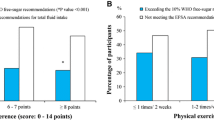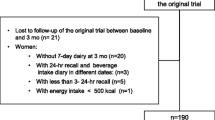Abstract
Purpose
We aimed to evaluate associations between compliance with recommendations for total water intake (TWI) and total water intake from fluids (TWIF), and some socio-demographic and lifestyle factors of a senior Mediterranean population at high cardiovascular risk.
Methods
Cross-sectional analysis with data of 1902 participants from the PREDIMED-Plus study. A validated 32-item Spanish fluid-intake questionnaire was used to assess beverage consumption and water intake. Multivariable logistic regression models were used to assess the odds ratio (OR) and the 95% confidence interval (CI) for complying with European Food Safety Agency recommendations for TWI and TWIF according to various socio-demographic and lifestyle factors, and for the joint associations of Mediterranean diet (MedDiet) adherence and moderate–vigorous physical activity (MVPA).
Results
The mean total volume of fluid intake in the population studied was 1934 ± 617 mL/day. Water was the most frequently consumed beverage. Significant differences between sex were only observed in alcoholic and hot beverage consumption. Compliance with TWIF was associated with being women (OR 3.02; 2.40, 3.80), high adherence to MedDiet (OR 1.07; 1.02, 1.12), and participants who were more engaged in physical activity (PA) (OR 1.07; 1.02, 1.13). Age was inversely associated (OR 0.96; 0.94, 0.98). Similar results for TWI recommendations compliance were observed in relation to being women (OR 5.34; 3.85, 7.42), adherence to MedDiet (OR 1.16; 1.02, 1.31) and PA (OR 1.07; 1.00, 1.15). The joint association of PA and MedDiet, showed that participants with higher adherence to MedDiet and meeting WHO recommendations for MVPA complied better with the TWI recommendations (OR 1.66; 1.19, 2.32).
Conclusions
High compliance with recommendations for TWI was associated with being a woman, and a healthy lifestyle characterized by high adherence to the MedDiet and PA.



Similar content being viewed by others
References
Panel on Dietary Reference Intakes for Electrolytes and Water F, and Nutrition Board I of M (2004) Dietary reference intakes for water, potassium, sodium, chloride, and sulfate. National Academic Press, Washington, DC. https://www.nap.edu/read/10925/chapter/1. Accessed 10 Oct 2018
Lotan Y, Buendia Jiménez I, Lenoir-Wijnkoop I, Daudon M, Molinier L, Tack I et al (2013) Increased water intake as a prevention strategy for recurrent urolithiasis: major impact of compliance on cost-effectiveness. J Urol 189:935–939. https://doi.org/10.1016/j.juro.2012.08.254
Ritz P, Berrut G (2005) The importance of good hydration for day-to-day health. Nutr Rev. https://doi.org/10.1111/j.1753-4887.2005.tb00155.x
Drewnowski A, Rehm CD, Constant F (2013) Water and beverage consumption among adults in the United States: cross-sectional study using data from NHANES 2005–2010. BMC Public Health 13:1068. https://doi.org/10.1186/1471-2458-13-1068
Panel on Dietetic Products N and A (2010) Scientific opinion on dietary reference values for water. EFSA J 8:1459. https://doi.org/10.2903/j.efsa.2010.1459
Duffey KJ, Popkin BM (2006) Adults with healthier dietary patterns have healthier beverage patterns. J Nutr 136:2901–2907. https://doi.org/10.1093/jn/136.11.2901
Sánchez-Villegas A, Toledo E, Bes-Rastrollo M, Martín-Moreno JM, Tortosa A, Martínez-González MA (2009) Association between dietary and beverage consumption patterns in the SUN (Seguimiento Universidad de Navarra) cohort study. Public Health Nutr 12:351–358. https://doi.org/10.1017/S1368980008002127
Estruch R, Salas-Salvadó J (2013) Towards an even healthier mediterranean diet. Nutr Metab Cardiovasc Dis 23:1163–1166. https://doi.org/10.1016/j.numecd.2013.09.003
Sánchez-Villegas A, Delgado-Rodríguez M, Martínez-González MÁ, De Irala-Estévez J, Seguimiento Universidad de Navarra Group (2003) Gender, age, socio-demographic and lifestyle factors associated with major dietary patterns in the Spanish project SUN (Seguimiento Universidad de Navarra). Eur J Clin Nutr 57:285–292. https://doi.org/10.1038/sj.ejcn.1601528
Ferreira-Pêgo C, Babio N, Salas-Salvadó J (2017) A higher Mediterranean diet adherence and exercise practice are associated with a healthier drinking profile in a healthy Spanish adult population. Eur J Nutr 56:739–748. https://doi.org/10.1007/s00394-015-1117-5
Alberti K, Eckel R, Grundy S, Zimmet PZ, Cleeman JI, Donato KA et al (2009) Harmonizing the metabolic syndrome: a joint interim statement of the international diabetes federation task force on epidemiology and prevention; National heart, lung, and blood institute; American heart association; World heart federation; International. Circulation 120:1640–1645. https://doi.org/10.1161/CIRCULATIONAHA.109.192644
Martínez-González MA, Buil-Cosiales P, Corella D, Bulló M, Fitó M, Salas-Salvadó J et al (2018) Cohort profile: design and methods of the PREDIMED-Plus randomized trial. Int J Epidemiol. https://doi.org/10.1093/ije/dyy225
Ferreira-Pêgo C, Nissensohn M, Kavouras SA, Babio N, Serra-Majem L, Salas-Salvadó J et al (2016) Beverage Intake Assessment Questionnaire: relative validity and repeatability in a Spanish population with metabolic syndrome from the PREDIMED-PLUS study. Nutrients 8:1–13. https://doi.org/10.3390/nu8080475
Palma I, Farra A, Cantós D (2008) Tablas de composición de alimentos por medidas caseras de consumo habitual en España. S.A. MCGRAW-HILL/INTERAMERICANA DE ESPAÑA, Madrid
Red BEDCA (2007) Base de Datos Española de Composición de Alimentos. http://www.bedca.net/. Accessed 9 Mar 2018
Fresenius Kabi España Fresenius Kabi España. Productos. https://www.fresenius-kabi.com/es/. Accessed 9 Mar 2018
Schröder H, Fitó M, Estruch R, Martínez-González MA, Corella D, Covas MI et al (2001) A short screener is valid for assessing Mediterranean diet adherence among older Spanish men and women. J Nutr 141:1140–1145. https://doi.org/10.3945/jn.110.135566
Martínez-González MA, López-Fontana C, Varo JJ, Sánchez-Villegas A, Martinez JA (2005) Validation of the Spanish version of the physical activity questionnaire used in the Nurses’ Health Study and the Health Professionals’ Follow-up Study. Public Health Nutr 8:920–927
Molina L, Sarmiento M, Peñafiel J, Donaire D, Garcia-Aymerich J, Gomez M et al (2017) Validation of the regicor short physical activity questionnaire for the adult population. PLoS One 12:1–14. https://doi.org/10.1371/journal.pone.0168148
Ainsworth BE, Haskell WL, Herrmann SD, Meckes N, Bassett DR Jr, Tudor-Locke C et al (2011) 2011 compendium of physical activities: a second update of codes and MET values. Med Sci Sports Exerc 43:1575–1581. https://doi.org/10.1249/MSS.0b013e31821ece12
World Health Organization (2010) Global recommendations on physical activity for health. https://www.who.int/dietphysicalactivity/factsheet_olderadults/en/. Accessed 12 Jan 2019
Nissensohn M, Sánchez-Villegas A, Ortega RM, Aranceta-Bartrina J, Gil Á, González-Gross M et al (2016) Beverage consumption habits and association with total water and energy intakes in the Spanish population: Findings of the ANIBES study. Nutrients. https://doi.org/10.3390/nu8040232
Ferreira-Pêgo C, Babio N, Fenández-Alvira JM, Iglesia I, Moreno LA, Salas-Salvadó J (2014) Fluid intake from beverages in Spanish adults; cross-sectional study. Nutr Hosp 29:1171–1178. https://doi.org/10.3305/nh.2014.29.5.7421
Zazpe I, Sánchez-Tainta A, Toledo E, Sánchez-Villegas A, Martínez-González MÁ (2014) Dietary patterns and total mortality in a Mediterranean cohort: the SUN project. J Acad Nutr Diet 114:37–47. https://doi.org/10.1016/j.jand.2013.07.024
Phillips PA, Rolls BJ, Ledingham JG, Forsling ML, Moton JJ, Crowe MJ et al (1984) Reduced thirst after water deprivation in healthy elderly men. N Engl J Med 311:753–759
Latzka WA, Montain SJ (1999) Water and electrolyte requirements for exercise. Clin Sports Med 18:513–524. https://doi.org/10.1016/S0278-5919(05)70165-4
Greenleaf JE, Bernauer EM, Juhos LT, Young HL, Morse JTSR (1977) Effects of exercise on fluid exchange and body composition in man during 14-day bed rest. J Appl Physiol Respir Env Exerc Physiol 43(1):126–132. https://doi.org/10.1152/jappl.1977.43.1.126
Guelinckx I, Ferreira-Pêgo C, Moreno LA, Kavouras SA, Gandy J, Salas-Salvadó J et al (2015) Intake of water and different beverages in adults across 13 countries. Eur J Nutr 54:45–55. https://doi.org/10.1007/s00394-015-0952-8
IARD IA for RD (2019) Drinking guidelines: general population. http://www.iard.org/resources/drinking-guidelines-general-population/. Accessed 25 Jan 2019
León-Muñoz LM, Galán I, Donado-Campos J, Sánchez-Alonso F, López-García E, Valencia-Martín JL et al (2015) Patterns of alcohol consumption in the older population of Spain, 2008–2010. J Acad Nutr Diet 115:213–224. https://doi.org/10.1016/j.jand.2014.08.017
Bibiloni M, Gonzalez M, Julibert A, Llompart I, Pons A, Tur JA (2017) Ten-year trends (1999–2010) of adherence to the Mediterranean diet among the Balearic Islands’ adult population. Nutrients. https://doi.org/10.3390/nu9070749
Ballesteros-Pomar MD, Rubio-Herrera MA, Gutiérrez-Fuentes JA, Gómez-Gerique JA, Gómez-de-la-Cámara A, Pascual O, Campina S (2000) Dietary habits and cardiovascular risk in the Spanish population : the DRECE study (I). Ann Nutr Metab. https://doi.org/10.1159/000012831
Moreiras O, Carbajal A, Cabrera L CC (2016) Ingestas diarias recomendadas de energía y nutrientes para la población española. In: Tablas de composición de alimentos, 18a. Ediciones Pirámide (Grupo Anaya, SA)
Mc D, Popkin BM (2010) Impact of water intake on energy intake and weight status: a systematic review. Nutr Rev 68:505–521. https://doi.org/10.1111/j.1753-4887.2010.00311.x
Imamura F, O’Connor L, Ye Z, Mursu J, Hayashino Y, Bhupathiraju SN et al (2016) Consumption of sugar sweetened beverages, artificially sweetened beverages, and fruit juice and incidence of type 2 diabetes: systematic review, meta-analysis, and estimation of population attributable fraction. Br J Sport Med 50:496–504. https://doi.org/10.1136/bjsports-2016-h3576rep
Acknowledgements
CIBEROBN, CIBERESP and CIBERDEM are initiatives of Instituto de Salud Carlos III, Spain. The authors especially thank the PREDIMED-Plus participants for their enthusiastic collaboration, the PREDIMED-Plus personnel for outstanding support, and the personnel of all associated primary care centres for their exceptional effort.
Funding
The PREDIMED-Plus trial was supported by the official funding agency for biomedical research of the Spanish government, ISCIII, through the Fondo de Investigacion para la Salud (FIS), which is co-funded by the European Regional Development Fund (four coordinated FIS projects led by Jordi Salas Salvadó and Josep Vidal, including the following projects: PI13/00233, PI13/00462, PI13/00728, PI13/00272, PI13/01123, PI14/01919, PI14/01722, PI14/01374, PI14/00636, PI14/01206, PI16/00533, PI16/00501, PI16/00366, PI16/01873, PI16/01094, PI17/00926, PI17/00764, PI17/01827, PI17/01441. The Special Action Project entitled: Implementación y evaluación de una intervención intensiva sobre la actividad física Cohorte PREDIMED-Plus Grant to J. S.-S., the European Research Council (Advanced Research Grant 2013–2018, 340918) to M. A. M.-G., the Recercaixa Grant to J. S.-S. (2013ACUP00194), a Grant from the Generalitat Valenciana (PROMETEO/2017/017). Indira Paz Graniel receives a Grant from the Spanish Ministry of Education, Culture and Sports (FPU 17/01925). Laura Gallardo Alfaro receives a Grant from the Spanish Ministry of Education, Culture and Sports (FPU 15/06147). Laura Barrubés receives a Grant from the Spanish Ministry of Education, Culture and Sports (FPU 16/00165). None of the funding sources took part in the design, collection, analysis or interpretation of the data, or in the decision to submit the manuscript for publication.
Author information
Authors and Affiliations
Contributions
IP-G, NB-T, NB and JS-S conducted the statistical analyses and drafted the article. IP-G, JS-S, NB and NB-T made substantial contributions to the conception and design of the work. All authors contributed substantially in the acquisition of data or analysis and interpretation of data. All authors revised the article critically for important intellectual content. All authors approved the final version to be published.
Corresponding authors
Ethics declarations
Conflict of interest
J. S.-S. reports serving on the board of the International Nut and Dried Fruit Council from which he has also received grant support through his institution, receiving consulting fees from Danone, Font Vella Lanjaron, Nuts for Life, and Eroski, and being given grant support through his institution from Eroski. J.S.-S is member of the executive committee of the Instituto Danone Spain and member of the scientific committee of the Institute Danone International. L. D. reports to receive a Grant from the Fundación Cerveza y Salud. N.-B. declares that she received payments from Danone S.A. for the purposes of scientific and technical consulting but not for preparing this study and grant support through his institution from Font Vella Lanjaron. No other potential conflicts of interest relevant to this article were reported.
Ethical standards
All participants provided written informed consent, and the study protocol and procedures were approved according to the ethical standards of the Declaration of Helsinki.
Electronic supplementary material
Below is the link to the electronic supplementary material.
Rights and permissions
About this article
Cite this article
Paz-Graniel, I., Babio, N., Serra-Majem, L. et al. Fluid and total water intake in a senior mediterranean population at high cardiovascular risk: demographic and lifestyle determinants in the PREDIMED-Plus study. Eur J Nutr 59, 1595–1606 (2020). https://doi.org/10.1007/s00394-019-02015-3
Received:
Accepted:
Published:
Issue Date:
DOI: https://doi.org/10.1007/s00394-019-02015-3




